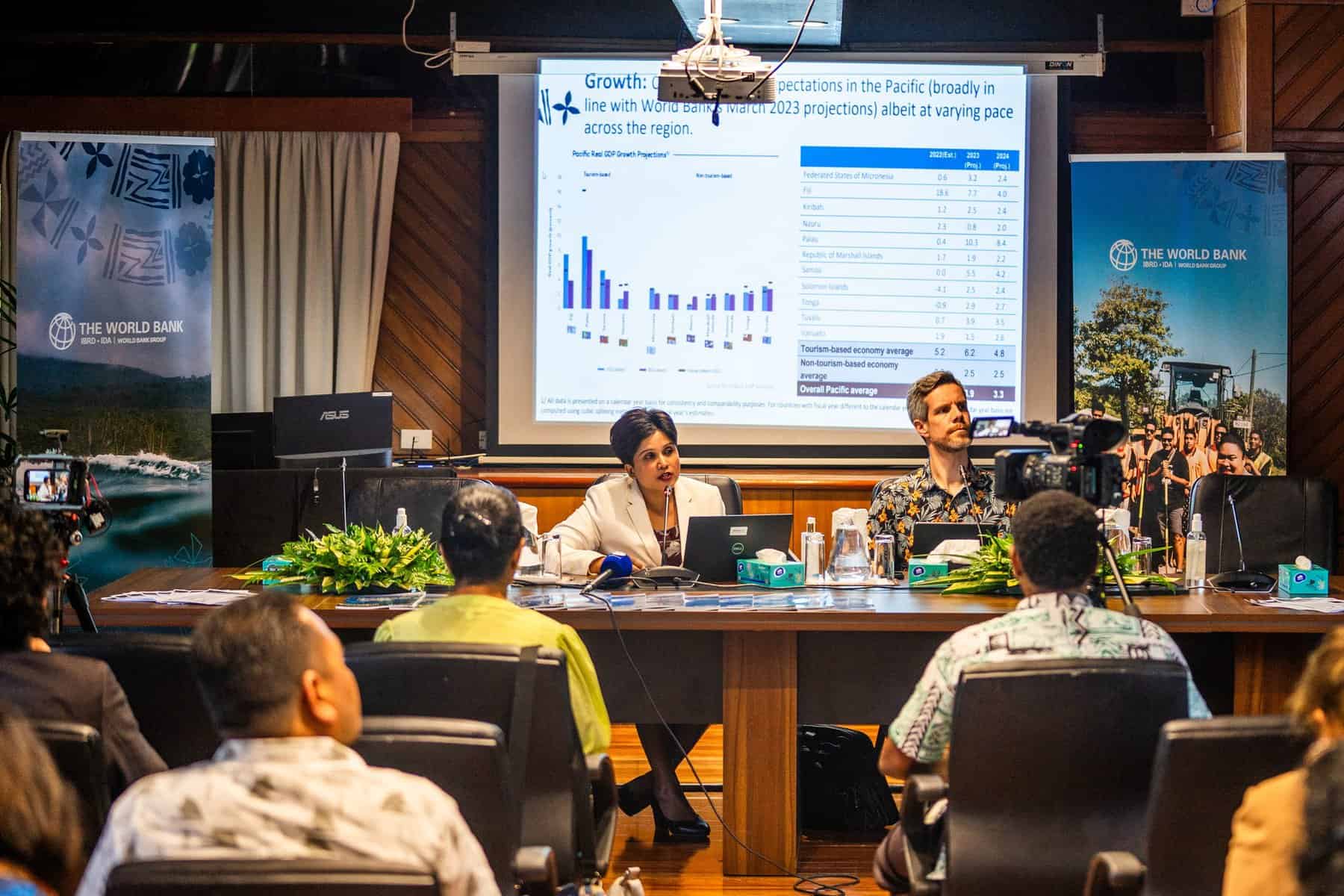The resumption of tourism, higher public investment and construction have fuelled the Pacific region’s economic recovery from COVID-19 but a combination of persistently high imported inflation and interest rate hikes in major markets is forecast to pull down GDP forecasts for 2024, according to new forecasts released by the World Bank.
According to the World Bank’s second Pacific Economic Update for the year, growth in the region is expected to accelerate to 3.9% this year, up from 2% in 2022, then moderate to 3.3% next year as the initial post-COVID-19 rebound fades and the region returns to its long-term trend growth of 2.6%.
“Most Pacific countries are projected to reach their pre-pandemic GDP level by 2024,” said World Bank Economist for the Pacific, Reshika Singh.
“For tourism-based economies, international travel mainly explains the recovery path. For others, the effects of the post-pandemic border reopening will be evident in higher public investment and construction. Continued strong remittance inflows will also support consumption and growth, particularly in Samoa and Tonga.”
Fiji is expected to continue leading the Pacific’s recovery from the pandemic, starting with a strong rebound in 2022 (18.6 percent) and continuing into 2023 (7.7 percent), owing to a revival of tourism. Robust growth is also projected for Palau (10.3 percent), Samoa (5.5 percent), Tuvalu (3.9 percent), and the Federated States of Micronesia (3.2 percent).
However, the increases in tourism and remittances will take a hit from the high interest rates in the major trading partners of the Pacific, particularly Australia and New Zealand, where demand “remains lacklustre”.
Speaking at the launch of the report prior to the start of the Pacific Islands Forum Economic Ministers Meeting (FEMM) in Suva, Fiji, last week, Singh said the World Bank has been supporting a number of Pacific Island countries to build their social protection systems in a way that is responsive in the event of natural disasters.
“We have also been involved in developing asset management policies to say, for example, how complex it is to hold the assets that they have and how they protect their assets during natural disasters,” she said.
Meanwhile, Vanuatu High Commissioner to Fiji, Viranria Brown, told Islands Business at the Pacific Islands Forum Secretariat in Suva – the venue of the FEMM gathering – that the tourism sector has not helped Vanuatu get back on its feet after being impacted by two cyclones in March last year.
Brown says that the government is looking at ways to increase the resilience of their systems and aims to build robust infrastructure that supports that.
“We’re working on some strategies at the regional level on how we can work with member countries, which have been very supportive in recovery plans after the two cyclones. We have just a little bit of the $91 million that was saved from the post-disaster assessment,” she said.
“We’re recovering and planning to prepare ourselves for the next one to come with a better solution before the next cyclone season, which is in November.”
Uncertainty over global commodity price swings, geopolitical tensions, slower growth among key trading partners, and the region’s vulnerability to natural disasters are all possible threats to the Pacific economic recovery. Many Pacific countries rely heavily on energy and food imports, and persistently high worldwide food and energy prices will result in long-term pricing pressures in the region, potentially driving vulnerable populations into poverty, the World Bank has warned.
Vice President of Kiribati, Tauea Toatu, told Islands Business, Kiribati is still experiencing elevated inflation because of the delayed effects from attempts to normalise commodity prices through price subsidies on transport and fuel. Earlier this year, Kiribati also launched its first Green Climate Fund (GCF) water project.
“Efforts are being made to access climate finance pledges under the UN Framework Convention on Climate Change and we are working with stakeholders to improve the lives of the people of Kiribati,” said Toatu.
Remittances have become a major income source in Pacific Island countries, the Pacific being home to six of the top 10 remittance receivers in the East Asia and Pacific area in terms of GDP share. Four out of every five households in Tonga and Samoa receive remittances from overseas, with remittance income accounting for an average of 30% and 8% of household expenditure.
“Pacific workers engaged in labour mobility programmes earn significantly more overseas than they would at home, with the latest estimates showing Tongan seasonal workers in Australia and New Zealand make three to four times more than they could at home. For ni-Vanuatu workers, it’s up to ten times as much,” said World Bank Programme Leader for Human Development in the Pacific, Thomas Walker.
According to the Pacific Economic Update, involvement in labour mobility schemes may build family bonds, empower women, and improve health and education results for migrants’ families.
Despite the economic benefits, there also are substantial drawbacks, such as workers’ extended absences from home, discontent with salaries and health care, and the danger of losing competent workers in their home countries.
Walker said that to obtain the greatest advantage from labour mobility initiatives, Pacific nations must spend more on education and training, especially via programmes to assist returning migrant workers. Improvements to the business climate in Pacific nations can also assist the countries develop more and better employment.
